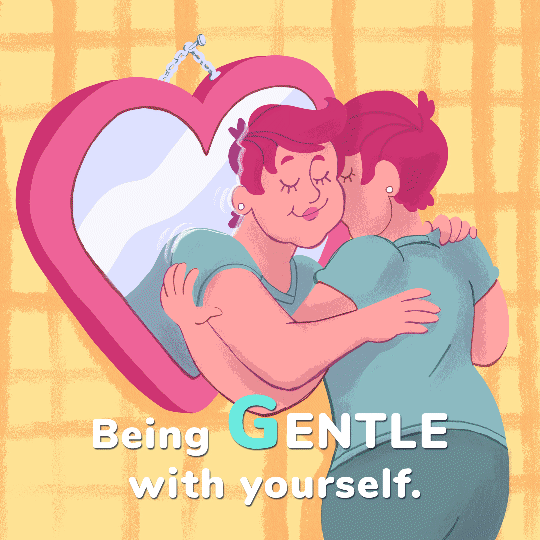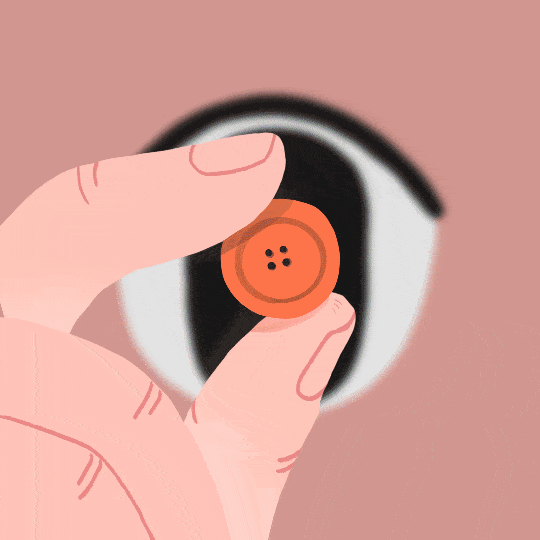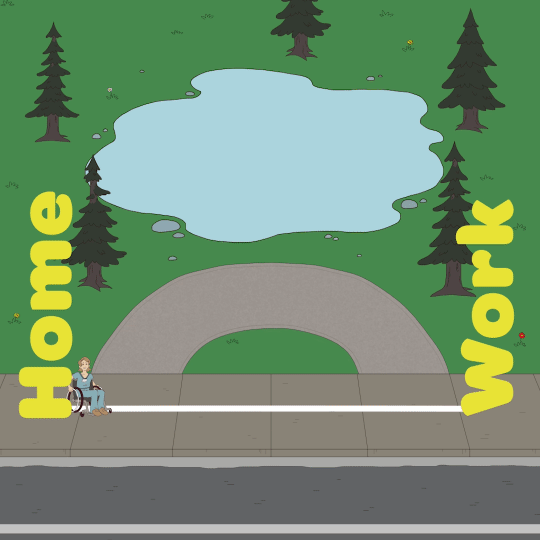
Mental health tool kit
Incorporate a variety of strategies into your daily life so you have a tool kit of options available when needed.

G.I.V.E. C.A.R.E.
At times, you can be your own worst critic. When you find yourself questioning your ability to bounce back, know that you can do something different, and it is okay if you make mistakes as you learn.
Let’s get to a place where you’re going to:
- Learn something new.
- Practice it.
- Give yourself credit.
Don’t forget to G.I.V.E. C.A.R.E. along the way:
- G → Be gentle with yourself.
- I → Take interest in why you might be feeling this way and whether you might be missing something that might change how you’re feeling.
- V → Validate, recognize, and acknowledge your suffering. Be fair to yourself in understanding that you are not alone, and that suffering is part of being human.
- E → Address yourself in an easy manner. Be kind, gentle, and fair with yourself, even if you’re unable to do things as you’d like right now.
- C → Be curious about your options. What could really help you in this moment?
- A → Acknowledge that change is hard and doing things differently is difficult.
- R → Reflect on which of your options is most likely to help you get to where you want to be.
- E → Triple-e encourage yourself to go through with the option that you’ve decided is best, even and especially when it’s hard.
Hand-on-heart exercise
Take a deep breath in. On the exhale, place your right hand over your heart and your left hand on top.
Next, breathing normally, notice:
- The sensation of your hands on your heart.
- The warmth flowing from your hands on your chest.
- The gentle pressure.
Keeping your hands in place, send warmth, caring, and compassion into your chest. Spend a few more minutes here. There is no hurry and no limit to the amount of compassion you can send and receive. Practice compassion through this exercise whenever or wherever you are, including at work.
Practice grounding
Practice grounding by using a raisin or small candy, such as a jellybean, to centre yourself in the present. Keep a container of your preferred snack nearby to use this strategy when experiencing a stressor.
- Holding: Pick up a raisin and hold it in the palm of your hand.
- Sight: Pay attention to the raisin. What are some noticeable features? What colour is it?
- Smell: Bring the raisin to your nose. How would you describe the smell?
- Touch: Close your eyes. What does it feel like? Is it smooth, soft, bumpy, rough?
- Taste: Place the raisin on your tongue. Can you taste it? Chew slowly. What does it taste like now?
- Follow: As you swallow, pay attention to the feeling of the raisin passing down your throat. Is there an aftertaste? How does your body feel after this exercise?

Tame the thought monster
Choose a thought that you find particularly bothersome.
Label your thought as a thought: If you are thinking, “Bob is a jerk,” say to yourself, “I am having the thought that Bob is a jerk” or “I am telling myself the story that Bob is a jerk.”
Appreciate what your mind is trying to do: Say to yourself, “I really get that you are trying to be of use. You are trying to keep me out of trouble and make sense of a difficult situation. Thanks.”
Repeat your negative thought out loud: Say it with a silly voice, such as Eeyore from Winnie-the-Pooh.
Notice when you are being “hooked” by the thought: Choose to become unhooked.
Notice when you are “buying into” a judgmental or blaming thought: Ask yourself, have I bought into this thought before? Is this an old and familiar pattern? Will buying into this story lead to a more fulfilling life, or will it lead to more pain and suffering in the long run?
Practice S.T.O.P.
Starting to feel too much or too little? These are signs that you’re at risk of acting from either your survival brain (based on defensive instincts) or emotional brain (based on emotion), not from your learning brain (based on thought).
At such times, practice the S.T.O.P. skill to connect with your learning brain:
- S → Stop: Instead of acting out of a sense of overwhelm, take a moment to pause.
- T → Take a step back: Do some deep breathing and/or grounding. Give yourself space to evaluate what is going on before acting.
- O → Observe: Notice what’s going on around you and inside of you.
- P → Proceed mindfully: Ask yourself “What can I do that is most likely to help me effectively address in this situation?” or “What choices might make this situation better or worse?” or “What actions will help me be successful?”

5-4-3-2-1 grounding
Use the 5-4-3-2-1 grounding technique to mindfully take in the details of your surroundings using each of your senses.
Notice:
- Five things you see.
- Four things you hear.
- Three things you feel.
- Two things you smell.
- One thing you taste.
Try to notice small details that your mind would usually tune out, such as distant sounds or the texture of an ordinary object.
Cold splash
Splashing cold water on your face from, say, a sink or a bowl has two main effects:
- Providing a controlled shock to your system, which helps shift your focus from what is distressing you.
- The cold water will help reduce your heart rate, making you feel calmer and less anxious.
Half smile, willing hands
Stress can often lead to impacts on our bodies, but the reverse is also true: our bodies can have profound impacts on our minds.
To help your body communicate to your brain that you are okay, practice the half-smile, willing-hands strategies. These strategies can help us regulate our systems and feel better in the moment.
Half smile
- Relax the muscles in your face, starting with your forehead and moving down to your chin.
- Turn up the corner of your mouth very slightly to create a “half-smile” reminiscent of the Mona Lisa’s.
Willing hands
- Either sit comfortably, stand, or lie down for this exercise based on your preference.
- Ensure your muscles are fully relaxed.
- Place your hands palms up in your lap, if you are sitting, or find a comfortable position to hold them up while standing or laying down. Ensure your fingers are relaxed.
T.I.P. skills
When you are struggling to cope with intense emotions, you can use T.I.P. skills to calm these feelings.
T.I.P. stands for:
- Temperature: Cold temperatures can help reduce our heart rate when we are feeling overwhelmed. Splash cool water on your face, take a cold shower, or go outside for a walk if the weather is chilly.
- Intense exercise: Spend excess energy by engaging in an intense cardio exercise. This does not require a workout plan, just go for a run or do some jumping jacks.
- Paced breathing: Take a deep breath in through your nose for four seconds and then breathe out through your mouth for six seconds.
Body scan
The body scan is one of the most effective ways to begin a mindfulness meditation practice. The purpose is to tune in to your body — i.e., to reconnect to your physical self — and notice any sensations you’re feeling without judgment.
- Sit quietly or lie down
- Start at one end of your body and focus on each body part
- Notice any areas of tension and then try to soften or relax them
- Continue until you have mindfully scanned each part of your body
✳️ Learn more
Boxed breathing
Boxed breathing, also known as four-square breathing, involves:
- Inhaling to a count of four
- Holding air in your lungs for a count of four
- Exhaling at the same pace
- Holding your lungs empty for a count of four before beginning anew
It can help to visualize your breath travelling around the four edges of a square while breathing.
Grounding stones
You can self-soothe stress and anxiety using grounding stones. These smooth, coloured stones have historically been used as a means of stress relief and relaxation.
- Place the stone between your index finger and thumb.
- Gently move your thumb back and forth across the curve of the stone.
- Pay attention to why you picked up the stone.
- Accompany your steady breathing with positive thoughts and emotions.
Umbrella stretch
Relieve stress-related tension by engaging in the following movement practice:
- Inhale and raise arms
- Interlock fingers
- Palms to the sky
- Vertical stretch
- Release fingers
- Exhale and lower arms
Close your eyes and raise awareness to your heartbeat, breath, and surrounding sounds.
Take a few moments to yourself and repeat as needed.

Establish transition routines
To help yourself transition from work mode to home mode:
- Create a routine or decompression time. Allow time for rejuvenation to recover from the emotional or physical exhaustion you may be feeling.
- Listen to something that uplifts or relaxes you on the way home to help take your mind out of work.
- Have a signal with your spouse or family member that indicates you need time before interacting with them. E.g., thumbs down as you enter lets them know you had a difficult day and need a hug.
- When you get home, take the dog — or just yourself — out for a walk.
- Use meditative, grounding, or gratitude practices prior to reintegrating with your family.
Avoid information overload
Wanting to stay updated with current and notable events is expected. However, too much information can lead to you feeling negative, overwhelmed, and overstimulated. You can avoid some of these feelings by reducing the time and instances you check news and information sources to once or twice a day. Along with this, seeking out credible sources of information can also help you avoid misinformation and frustration. It is also a good idea to totally unplug and not look at your devices at least once a day, even briefly.
Cope in the moment
If you are at work and experiencing stress or overwhelming emotions, it can be difficult to cope with them in the moment. Here are some strategies you can implement when at work or even with a patient:
- Actively listen to what your patient or colleague is saying to keep you in the present.
- Clasp your hands tightly to use the sense of touch to ground you.
- Affirm: Remind yourself you can do this. Recall successful results in the past.
- Scan your environment and note key characteristics. Use your sense of touch to ground yourself.
- Walk slowly: Take notice of each step as you walk from one area to the next to help yourself reduce intense emotions.
Practice during calm periods
Use positive mental health support tools during calm periods to practice helpful skills. Having this repertoire of stress-relieving exercises at your fingertips will help to ensure that challenging moments will be more manageable.

Practice self-compassion
We are often our own harshest critics. We would not talk to our best friend the way we sometimes talk to ourselves.
Begin to give yourself the same love, kindness, and support you would give to your best friend. Be fair to yourself. Recognize when things are hard and encourage yourself, just as you would your friend.

Take a pause
You may feel as though your time is better spent doing other, more “urgent” tasks, but your mental health is just as important. Whether you can spare five minutes, five hours, or five days, you can work towards having helpful mental health tools on hand regardless of time.
Think about:
- Why are you overwhelmed in this exact moment
- What has helped you in the past (e.g., bath, grounding, pets, exercise, breathing)
- Who you can talk to about your experiences
Refill your own pitcher
It is challenging to acknowledge when a situation is hard, especially when you think it should be different. Here are some steps to help you accept things as they are and recognize when you are struggling to do this:
- Notice when you are trying to change or deny things that can’t be changed. This may lead to thoughts of despair or unfairness, or to feeling emotions such as anger and frustration.
- Remind yourself that “It is what it is,” and nothing can be done now. You may need to do this multiple times a day/hour/minute, depending on the situation and your mental state.
- While acknowledgment is important, so is allowing yourself to feel the emotions that come along with it, such as sadness and disappointment. These feelings are healthy.
Accept things as they are
It is challenging to acknowledge when a situation is hard, especially when you think it should be different. Here are some steps to help you accept things as they are and recognize when you are struggling to do this:
- Notice when you are trying to change or deny things that can’t be changed. This may lead to thoughts of despair or unfairness, or to feeling emotions such as anger and frustration.
- Remind yourself that “It is what it is,” and nothing can be done now. You may need to do this multiple times a day/hour/minute, depending on the situation and your mental state.
- While acknowledgment is important, so is allowing yourself to feel the emotions that come along with it, such as sadness and disappointment. These feelings are healthy.
Peer support
During the COVID-19 pandemic, healthcare providers reported increasing feelings of isolation and disconnection. Facilitating peer support and strong connections within your team is an effective way to mitigate adverse mental health outcomes.
Ensure structures are in place for colleagues to provide social support to one another — such as having the opportunity to take regular breaks or developing structured peer support groups/programs.
Additionally, leaders can encourage a supportive mental health culture to reduce fear of stigmatization and increase the likelihood of providers seeking support. Holding daily huddles to create a sense of belonging and building a sense of community through inclusion can be important steps to developing trust and safety within the team.

Organizations: Support staff taking vacations
Many Canadian healthcare providers experience burnout and exhaustion due to the physical, mental, and emotional toll of their roles. These pressures also lead to HCPs wanting to leave their organization or profession altogether. Ensuring HCPs have adequate time to rest can reduce these impacts and help with retention.
Implementing sick leave and vacation policies to provide adequate time off to care for personal wellbeing is critical for the mental health of HCPs. On top of this, placing limits on overtime and providing flexible schedules to account for personal circumstances can increase trust between leadership and staff, as well as support positive mental health.
Most importantly, creating a culture that does not stigmatize or punish individuals for taking time off is important for buy-in. Ensure staff feel comfortable asking for time off and provide explanations when vacation time is denied.
Organizations: Foster autonomy and respect
Hierarchical structures within healthcare systems can contribute to staff feeling undervalued. To demonstrate that the organization does indeed respect the expertise of each employee, some of the following strategies may be helpful to deconstruct these hierarchies:
- Implement shared decision-making models.
- Explain how policy and protocol changes are informed.
- Establish bidirectional communication processes and actively seek employees’ recommendations and feedback.
- Demonstrate how employee concerns are being addressed.
- Make leaders visible and available for staff to interact with regularly.